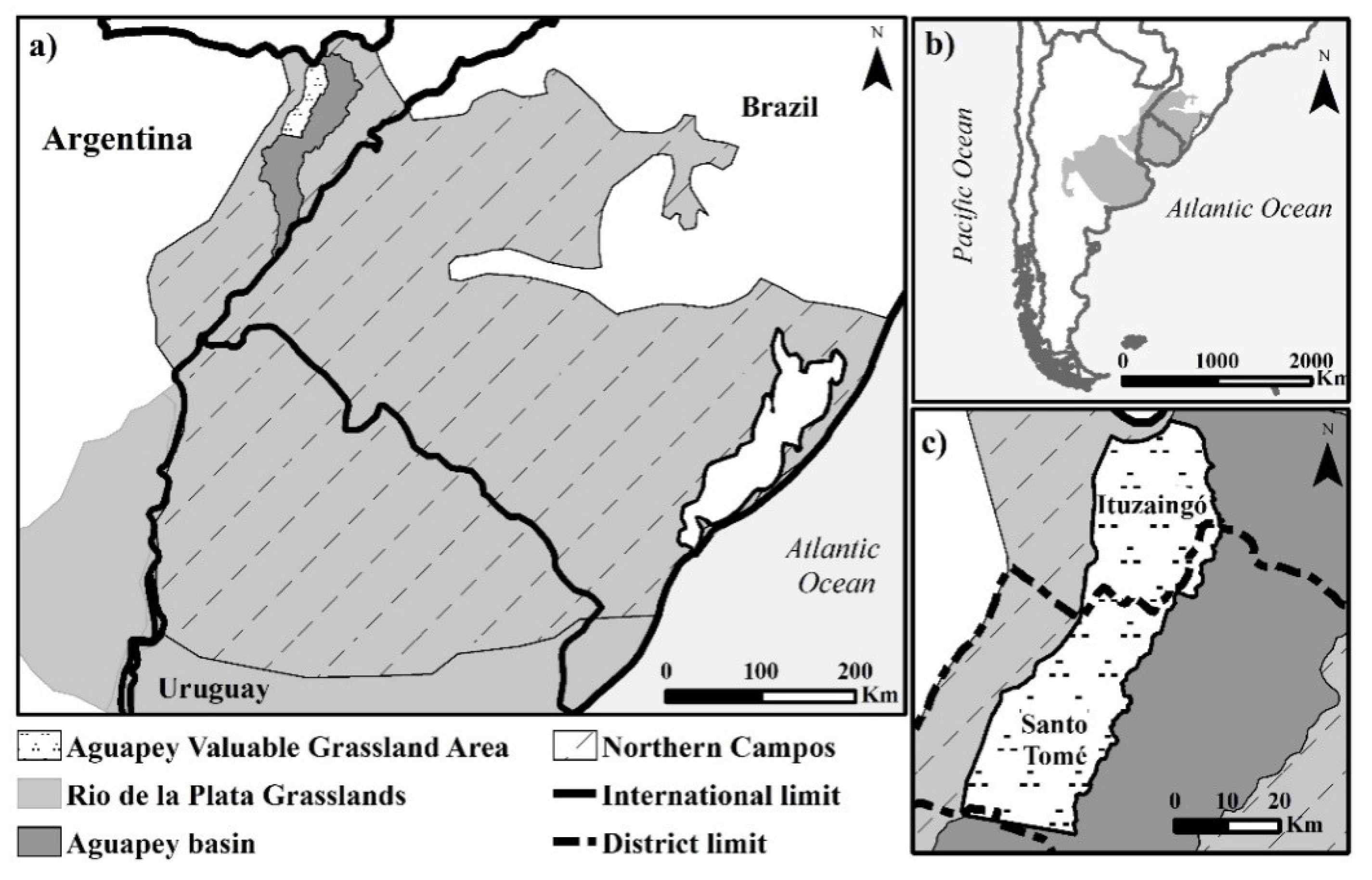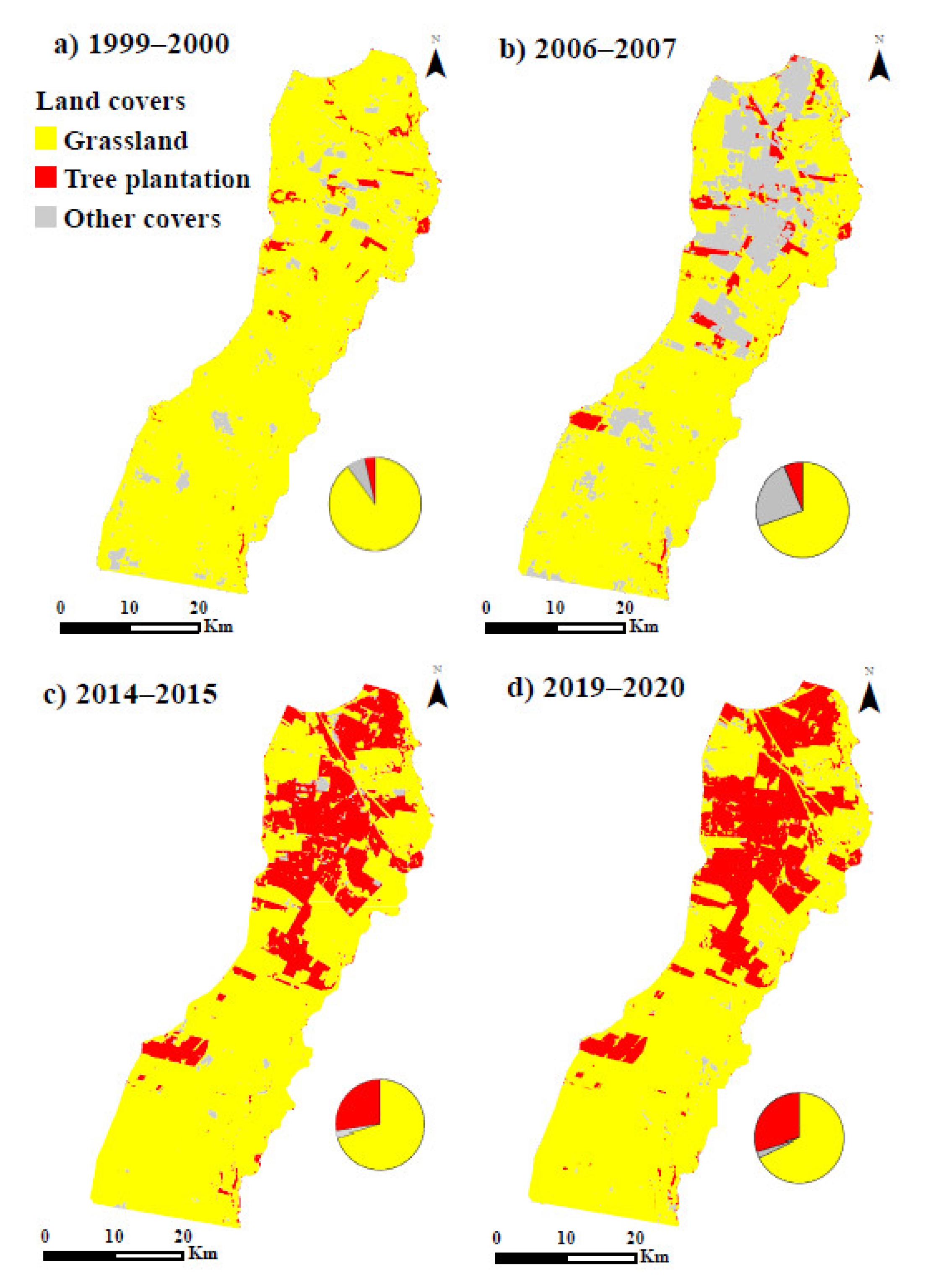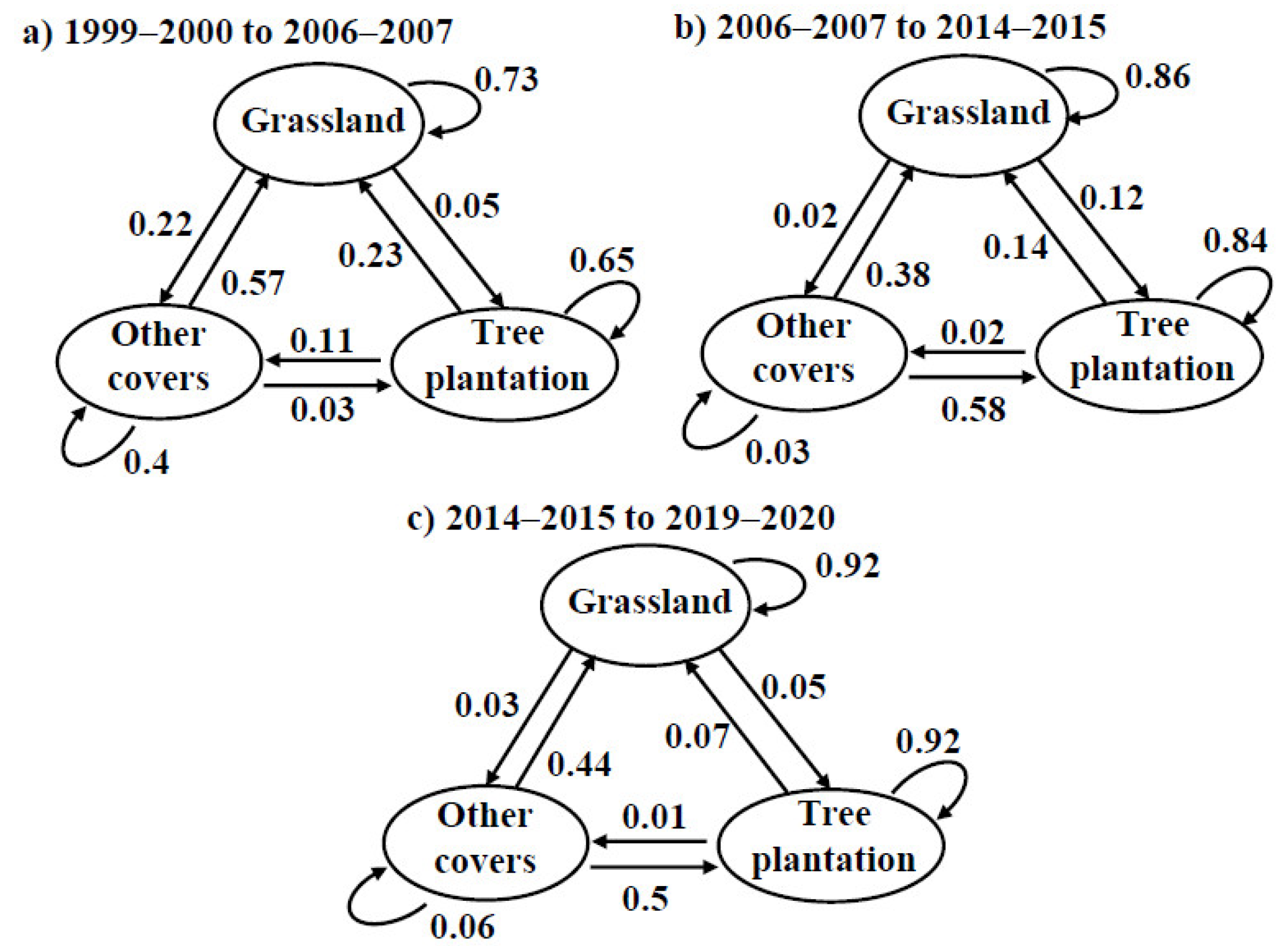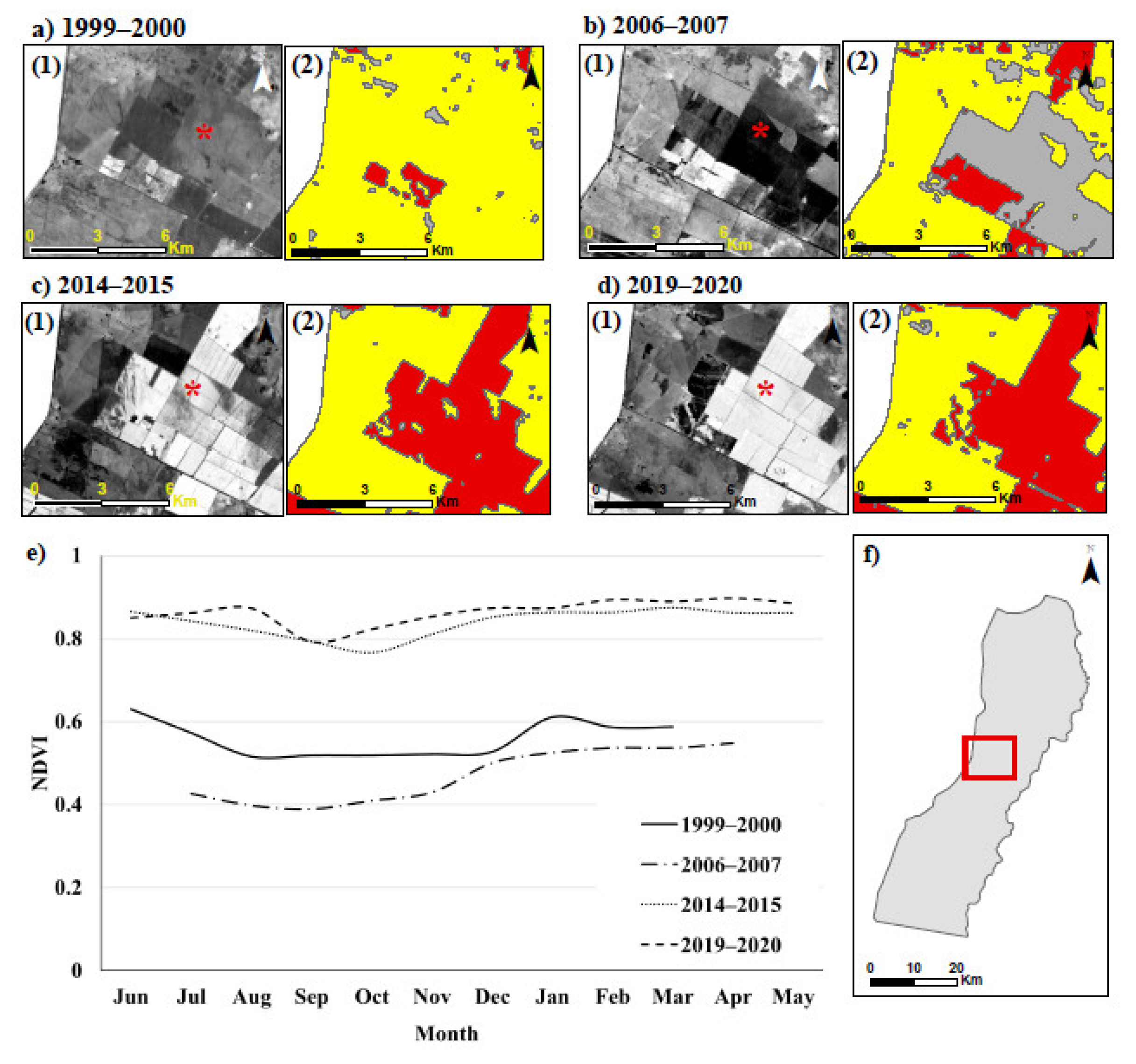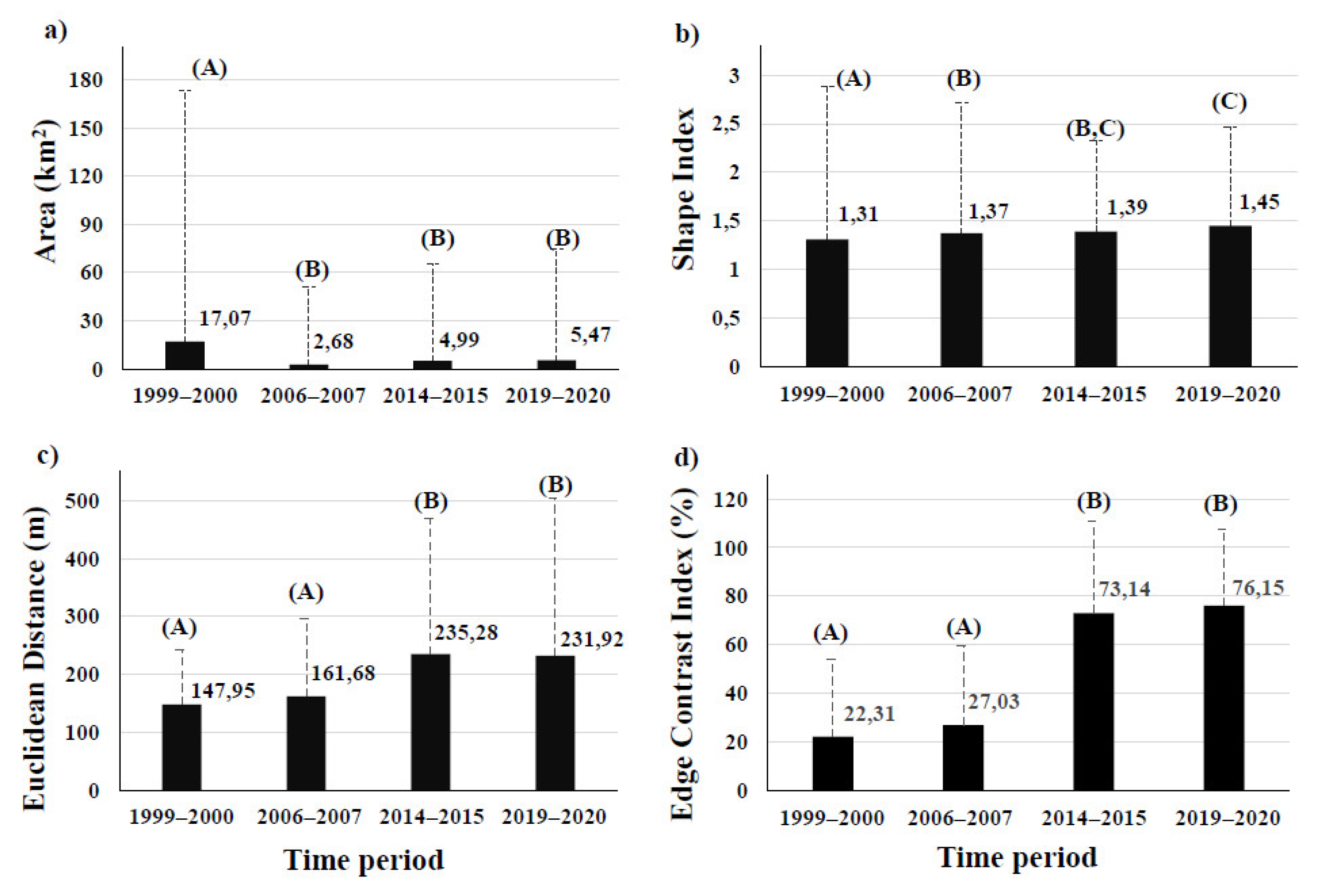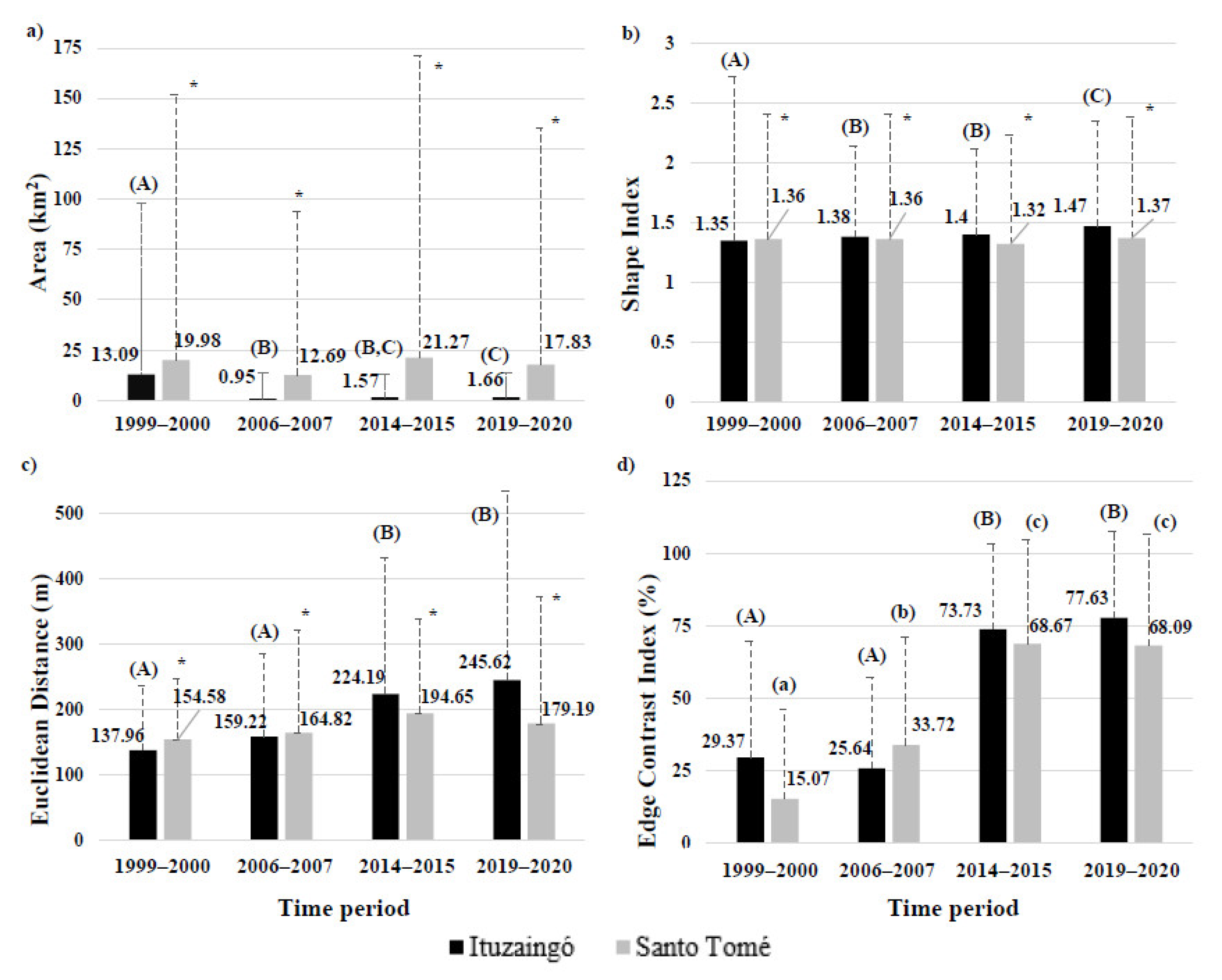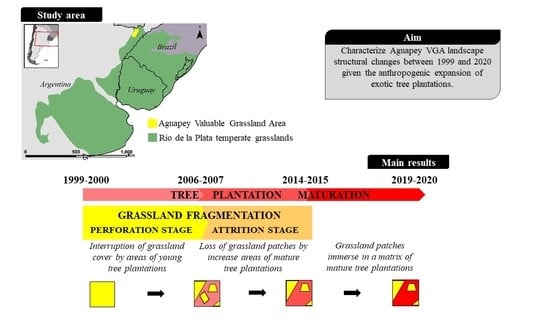1. Introduction
Temperate grasslands occupy circa 8% of the Earth’s terrestrial surface and are among the most biodiverse and productive ecosystems worldwide [
1]. Not only are they a habitat of with high diversity and an abundance of flora and fauna species, including many endemics and endangered species, temperate grasslands are also important for many plant food species of economic importance [
2]. Furthermore, they provide many important ecosystems services (e.g., nutrient recycling, pollination, habitat for livestock grazing, genetic diversity for crops, recreation, climate regulation) and play a key role in global carbon cycle: grasslands soils store as much carbon as forests do globally [
1,
3]. After centuries of human disturbance, temperate grasslands are considered one of the most altered and endangered ecosystems on most continents: about 41% of these grasslands have already been converted to agricultural use, 7.5% to commercial forestry, and almost 6% were replaced by urbanization [
1,
4]. Despite its critical conservation status, only 4.59% of these grasslands are under some level of protection [
5]. In a context of increasing threats by multiple anthropogenic activities, the remaining areas of native temperate grasslands take on a heightened importance for the conservation of biodiversity and ecosystem services that are essential to sustain human development and well-being [
3].
The Rio de la Plata Grasslands (RPG) are the main complex of temperate grassland ecosystems in South America, covering the large plains of central-east Argentina, Uruguay, and Southern Brazil. The RPG, originally characterized by the almost absolute absence of trees, are habitat for a conspicuous and unique biodiversity including more than 550 different grass species, 450 bird species, and nearly a hundred species of mammals [
6,
7]. Significant human transformation across this region started mainly at the beginning of the 20th century, with increasing European immigration and the replacement of native vegetation to agriculture [
6]. Over recent decades, the RPG have recorded some of the highest rates of land use change worldwide given their intensified use for livestock production and grasslands’ conversion to crops, implanted pastures, and exotic tree plantations [
8,
9]. Some of the remaining and most well-preserved temperate grassland areas in Argentina are located mostly in private land of the Northern Campos region (the Campos, hereafter) [
7,
10]. Only 0.15% of Campos grasslands have formal protection designation; therefore, many sites of high biodiversity are in a potentially vulnerable situation [
7].
In 1998, Argentina’s government enacted a law particularly aimed to promote and financially support the development of forestry plantations in different regions across the country, in order to supply the growing global demand of pulp and wood (Argentina’ National Law 25.080). This policy triggered a widespread land-use change across the country that led to the replacement of grassland areas used for cattle ranching activities by exotic tree monocultures [
11]. The afforestation development was particularly important across the Campos region given its exceptional climatic and edaphic conditions that prompt high annual growth rates of exotic tree species such as
Pinus spp. and
Eucalyptus spp. [
11,
12].
The severe ecological consequences of the conversion of a grass-dominated ecosystem to one dominated by trees (referred to as grassland afforestation) not only derives from the direct reduction of the original grassland cover [
13,
14,
15] but also from the indirect transformation of the spatial configuration of the landscape [
16,
17]. Grassland afforestation typically promotes grassland fragmentation, as the (formerly) locally continuous natural ecosystem is broken into smaller and more isolated fragments surrounded by a human-transformed matrix of tree plantations [
1,
18,
19]. Changes in the size and spatial configuration of remnant fragments are recognized to have a major effect, not only on population dynamics and species persistence [
19,
20] but also on the ecosystem processes that ultimately determine the provision of ecosystem services [
19,
21].
Fragmentation is a dynamic process of change that leads to different stages: perforation or incision, dissection, dissipation, shrinkage, and attrition [
22,
23]. The stage of fragmentation provides critical information not only to infer changes in the ecosystem (i.e., an early fragmentation stage could be interpreted as an early warning sign) but also for the development of suitable ecosystem management strategies [
21,
23,
24]. Despite its importance, studies of landscape fragmentation have typically been biased towards forest ecosystems [
24]. Only in recent years have grassland fragmentation studies gained more attention; however, grassland fragmentation induced by afforestation processes remains understudied [
25].
Within contemporary climate change mitigation scenarios, the development of the carbon market may accelerate the rate of grassland afforestation in the Campos region [
15,
26]. Furthermore, as part of Argentina’s national contribution to ‘the fight against climate change’ established in the Paris Agreement (2019), the National Government launched a new initiative to increase tree plantation cover by 50% in the period up to 2030 (which represents a total of 2 million hectares) [
27]. This situation has raised particular concern in the Aguapey Valuable Grassland Area (VGA), an area of high biodiversity conservation value within the Campos region [
3] which demonstrates favorable conditions for the establishment of tree plantations [
13,
28].
The potentially severe ecological consequences of the Campos grassland afforestation have started to be increasingly recognized [
13,
15,
29]. However, it is also necessary to further increase the current knowledge about the level of temperate grasslands’ fragmentation due to afforestation, in order to achieve a broader understanding of the afforestation impacts over temperate grasslands and support the development of land-use planning policies with a conservation focus. The development of robust methodologies to determine the current extent, and recent levels of loss and transformation, will be central to the development of successful mitigation measures and to secure the careful custodianship of this internationally important temperate grassland ecosystem in South America.
The aim of this study is to analyze the spatio-temporal changes in the landscape structure of the Aguapey VGA due to the afforestation process occurring between 1999 and 2020; and to understand the nature of landscape transformation across this period. For this purpose, grassland, and tree plantation cover within the Aguapey VGA are characterized in four time periods between 1999 and 2020 (1999–2000; 2006–2007; 2014–2015; 2019–2020) employing an unsupervised classification methodology, based upon a multi-temporal sequence of past and present Landsat multispectral images. Secondly, in order to provide a deeper understanding of the dynamics of change, a land covers’ transition probability analysis is made between the temporal periods. Finally, key landscape metrics were estimated to analyze the temporal changes that have occurred to the Aguapey VGA landscape structure, with focus on the loss and fragmentation of temperate grasslands.
4. Discussion
The research presented in this study addresses the analysis of the spatio-temporal changes manifesting in the landscape structure of one of the globally most well-preserved temperate grassland areas, the Aguapey VGA, Argentina. The study is conducted between 1999 and 2020 in a location considered an internationally important temperate grassland area, and a refuge for more than 10 globally endangered grassland species. The study findings assert that, during this study period, structural changes within the Aguapey VGA were principally driven by the expansion of exotic tree plantations (
Eucaliptus spp. and
Pinus spp.). Overall, the analyses indicate that a vast expansion of the forestry activity occurred, and that this expansion was at the expense of temperate grassland, which suffered area loss and fragmentation. This loss was temporally consistent with the establishment of the national afforestation policy enacted in the mid-1990s and the Aguapey region’s suitability for the development of this forestry activity [
11,
12]. In this regard, between 1999 and 2020, a total of 350.98 km
2 (≈22%) of the Aguapey VGA’s grassland were lost while tree plantation cover increased from 59.35 km
2 to 476.05 km
2 (almost 26% of the Aguapey VGA). Despite this significant land cover change, in 2019–2020 temperate grasslands remained the majority land cover of the Aguapey VGA, occupying almost 68% of the area. Its continuing dominance highlights its ongoing significance as a refuge for this internationally important grassland system that has characterized the RPG region for millennia prior to European colonization [
55].
A detailed analysis of different landscape metrics, together with the assessment of the transition proportion between land covers, revealed a complex transition dynamic between grassland and tree plantations that led to different fragmentation stages of temperate grasslands over the 20-year study period. Between 1999 and 2007, the loss of grassland cover, together with an increased density of patches of lower size and higher shape complexity, indicated the perforation process of the grassland [
22]. This was driven mainly by the conversion of grasslands into areas of bare soil and occupied by young tree stands that are spectrally characterized very differently to established forest vegetation. From 2006 to 2015, the decreased grassland patches, which were located at a higher distance from each other, and which showed higher structural contrast with the land cover that surrounded them, revealed that the grassland cover was going through an attrition process [
22,
24,
56], evidencing that tree plantations were establishing themselves during this period, and highlighting an increase in the intensity of the fragmentation process that had started in 1999. Contrary to the previous periods, from 2015 to 2020 a slight recovery noted by the reduced level of grassland fragmentation was recorded and supported by the decrease in patch density.
The previous analysis identified that the largest afforestation impacts in the region occurred between 1999 and 2006; and more specifically comprised of the perforation of the original grassland cover by emerging tree plantation stands (typically in their initial growth phases with young tree species and grasses coexisting). The identification of the early development of tree plantations between 1999 and 2007 places a spotlight on the contemporary move to forest activity; and provides an evidence base to suggest that the grassland loss and fragmentation was motivated by the national economic incentives for the development of forestry activity from the late-1990s onwards. However, the new analysis undertaken in this paper highlights that between 2007 and 2020 grassland cover remained relatively unchanged. This is potentially noteworthy as even during this later period the national afforestation policy remained in place; yet the apparent uptake by landowners was reduced.
The differences in the afforestation dynamics in the temporal period (1999–2020), highlighted in the current study, could indicate that other factors, in addition to the national policy, were influencing the structural changes across the Aguapey VGA. In this regard, it is pertinent to consider that the cattle ranching practice in the region is a tradition deeply rooted in the local culture [
32]. In 2006, local producers within the Campos region, together with BirdLife International and various national NGO’s, started working on a regional initiative, the “Southern Cone Grasslands Alliance” (
www.birdlife.org/americas/programmes; accessed on 8 August 2020). This initiative was created to enhance traditional cattle ranching practices and preserve the temperate grassland whilst also sustaining this environmentally sound economic activity [
57]. In addition, in 2012, the Alliance launched the project ‘Incentives for conservation of natural grasslands in the Southern Cone’ which provided financial support for local producers; and most significantly the Aguapey VGA was selected as one of the pilot sites for this project initiative. Therefore, the increasing interaction between local NGO’s and producers (with a common interest in continuing traditional rearing cattle practices), combined with the financial support for local farmers, may have interrupted the trend of exotic tree plantation expansion within the Aguapey VGA from 2007 onwards.
The analysis performed at district scale has revealed that the afforestation process within the Aguapey VGA took place mainly in the Ituzaingó district, where the loss of grassland amounted to more than 50% of the original cover; the evidence base shows that this loss in grassland was directly relative to an increase of approximately 700% of tree plantations in 20 years. Conversely, the Santo Tomé grassland cover remained relatively unchanged between the periods studied, and by 2019–2020 grassland was still the main land cover occupying ~87% of the district area. Considering that both Ituzaingó and Santo Tomé share the same environmental and cultural characteristics within the Aguapey VGA, it is highly probable that the observed disparity between districts is influenced by different factors at a local scale. For example, 65% of the Ituzaingó district is covered by the Iberá Natural Reserve (next to the west of the Aguapey VGA), where the development of the forestry industry is highly restricted by law (Argentina’s National Law 27.481). Therefore, a high concentration of tree plantations is expected in the remaining 35% of the district. Additionally, according to the First Forest Inventory of the Corrientes province [
33], most tree plantations within Santo Tomé were distributed outside the Aguapey VGA towards the eastern region of the district with better edaphic conditions for the development of forestry activity. These findings, together with the different Aguapey VGA afforestation dynamics observed between periods, highlight that the afforestation process across this region was determined by a complex interplay of environmental, social, political, and economic factors, providing further evidence to support previous studies which suggest that landscape change is not a random process; rather, disproportionate changes occur in certain areas or periods given the influence of a wide array of factors [
16,
23,
24,
47].
The analysis presented in this study has clearly demonstrated that the afforestation process which occurred in the Aguapey VGA between 1999 and 2020 induced the significant loss of an important temperate grassland area (mainly within the northern region). Previous studies in the Campos region reported major costs to species diversity and ecosystem services due to the replacement of grassland ecosystems by tree plantations. For example, Phifer et al., (2016) [
55] reported that Eucalyptus plantations reduced the richness and abundance of grassland-dependent bird species (such as
S. ruficollis and
R. americana) and their associated ecosystem services such as pest control, seed dispersal, and pollination. In addition, [
29,
58] registered that afforested temperate grasslands within the RPG led to localized water balance shifts which, in turn, triggered intense water and soil salinization processes, decreasing water and soil quality.
Furthermore, the substantial loss of temperate grassland systems has led to the isolation and segregation of many of the remnant grassland patches. The effects of habitat isolation on species’ population viability have been extensively studied (see [
19]); however, it has also been recognized that the fragmentation impacts are species-specific [
59,
60]. In this regard, [
13] stated that six globally threatened bird species, distributed within the Aguapey basin, were highly impacted by the presence of tree plantations, which not only affected their breeding habitats but also impeded their ability to disperse between habitat patches. The impacts of temperate grassland fragmentation have also been reported in regard to the endangered Pampas deer [
31]; however, a recent study suggested that Pampas deer could be positively selecting grassland patches within young tree plantations as refuge against predators [
61]. The ecological effects are therefore complex and warrant further study. On this basis we propose that further species-specific analysis should be developed in this region to better understand the species-specific effects of afforestation practices.
In recent years, several international initiatives, such as the Bonn Challenge and the New York Declaration on Forests, have established ambitious targets for forest cover in-creases, which are seen as necessary to limit global warming by 2050 [
62]. In order to achieve this ambitious goal the United Nations Framework Convention on Climate Change (UNFCCC) Clean Development Mechanism (CDM) promotes grassland ecosystems’ afforestation as one of many global mitigation strategies [
63], given the potential of forest industries to operate as a net sink for carbon [
64,
65]; furthermore, it was stated that afforestation projects have the most potential in developing countries due to the higher growth rates of forest and the land availability [
66]. In this regard, Argentina has launched a new initiative to increase by 50% the tree plantation cover in the next nine years [
27], overlooking the possible negative impacts that that the replacement of historic natural temperate grasslands with exotic tree monocultures induces on species diversity and the ecosystem services previously mentioned.
Although grassland afforestation can increase carbon uptake by considerably increasing the aboveground biomass accumulation [
15,
67,
68], this increment does not necessarily imply net long-term carbon sequestration [
69]. For example, it has been observed that afforestation can produce a net loss of soil organic carbon as a consequence of different C allocation patterns between grasses and trees [
70,
71,
72]; while other studies registered that a higher proportion of tree plantations’ NPP can be lost by fire or appropriated through harvesting [
73,
74].
Natural grasslands soils represent very large carbon sinks at global scale [
1,
2]; therefore, where grassland ecosystems are preserved and sustainably managed, their largely belowground soil organic carbon stocks are secure from disturbances such as fire, deforestation, and disease [
1,
74,
75]. Furthermore, a recent study reported that restoration of degraded grassland areas with high diversity of dominant grass species promoted high rates of soil carbon accumulation, increasing the ability of these areas to contribute to C sequestration [
76]. Given that soils’ natural grassland ecosystems could also play a key role in the carbon cycle, future studies should also be conducted which seek to assess the impact of temperate grassland loss and fragmentation on its role in carbon sequestration and to more critically examine the benefits of mixed land use to mitigate carbon emissions.
5. Conclusions
This study provides an insight into the impacts of the afforestation process between 1999 and 2020 in the Aguapey VGA. During the first 15 years, structural changes took place mainly within the northern region of the Aguapey VGA (Ituzaingó district) where grasslands were reduced to almost 50% of their original cover as a consequence of the expansion of tree plantations. This afforestation induced temperate grassland fragmentation, which initially included the perforation and subsequent attrition of grasslands. The structural changes within the Aguapey VGA were mainly a consequence of the national afforestation policy launched in the mid 1990s, which provided financial support for the development of the forestry industry; however, the traditional cattle ranching practices deeply rooted in the Aguapey region’s culture may have partially inhibited the expansion of tree plantations within the area.
Although the ecological processes impacted by grassland afforestation are not directly studied, the clear evidence of grassland fragmentation within the Aguapey VGA described in this paper provides critical information to suggest that severe changes will have occurred in this ecosystem. These changes should be considered as early warning signs to develop conservation actions and protect this undervalued land cover.
Currently, slightly above three quarters of the remaining, most-well preserved, temperate grasslands of the Aguapey VGA are distributed towards the southern region within the Santo Tomé district (from 1083.83 km
2 of grassland cover recorded in 2020, 820.13 km
2 are distributed across Santo Tomé district;
Table 3 and
Table 5). Since potentially irreparable changes have been shown to occur through afforestation of previous grassland areas over the space of a small number of years, and considering that it is highly probable that over the next years tree plantations will expand towards the southern region of the Aguapey VGA, urgent conservation land-use planning policies need to be developed to emphasise both the importance of the soil organic carbon stored in this region and its role as a habitat of globally endangered species. This is particularly prescient given the region’s lack of formal protection and the new national policies promoting afforestation activity. These planning policies should promote the placement of forestry systems in areas that minimise their impact on existent temperate grassland ecosystems, their biodiversity, and the ecosystem services that they provide.

